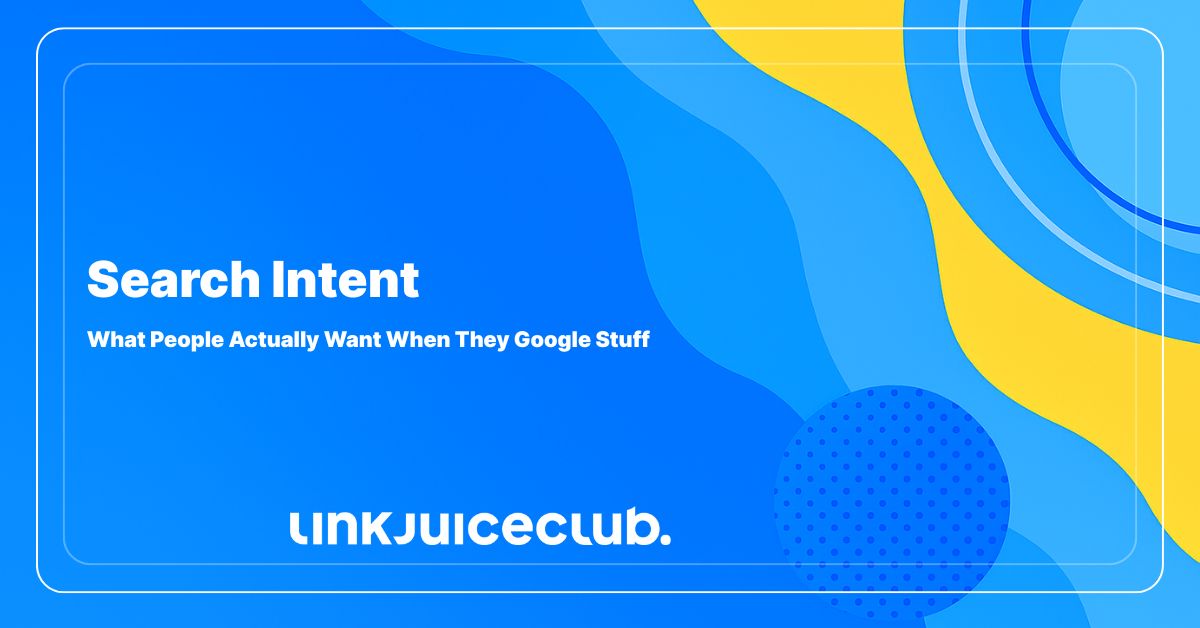
Search Intent: What People Actually Want When They Google Stuff
Search intent is all about figuring out what someone really wants when they hit search. Are they looking to buy, learn, compare, or just get to a specific page?
If your content doesn’t match that goal, Google won’t rank you, and users won’t stick around.
Say someone Googles best waterproof backpack under $100. They don’t want a generic list of our top travel tips. They want products, prices, comparisons… right now. Nail that intent, and you’ll get the click (and maybe the conversion).
The Four Faces of Search Intent
Understanding the reason behind a search helps you create content that actually delivers. Most search queries fall into one of four categories. Each type tells you what the user expects to find and what you need to give them.

1. Navigational Intent 🔎
The user already knows what site or platform they want. They’re using Google as a fast way to get there. Searches like LinkedIn login or Netflix homepage aren’t looking for options, they want a specific destination. If your brand or service is the end goal, make sure your page is easy to find and clearly titled.
2. Transactional Intent 🔍
These users are ready to take action: buy, sign up, subscribe, or download. You’ll spot this intent in keywords like buy, deal, price, or specific product names. If your page shows up here, it needs to be optimized for conversions. Clear messaging, strong CTAs, fast loading – no room for guesswork.
3. Informational Intent 🔎
Here, users are looking to learn something. They’re not ready to make a decision; they just want answers. These queries often start with how, why, what, or guide. Useful content like tutorials, blog posts, and FAQs work best. Keep it accurate, up-to-date, and easy to understand.
4. Commercial Investigation🔍
This is the research phase before a purchase. Users are comparing products or services to decide what fits best. To win here, create content that compares features, breaks down pros and cons, and helps users make informed choices.
Other Ways People Use Search
The four main types of search intent are helpful, but they don’t cover everything. People search for all kinds of reasons that don’t always fit neatly into a category.
Some want to compare products before buying. Others are just trying to find a nearby store or see what’s open. Plenty are looking for how-to guides on things like cooking or fixing something. And many are simply trying to solve a problem they’re stuck on.
Understanding these extra types of searches helps you create better content. The more closely your page matches what someone’s actually looking for, the better your chances of getting clicks.
Why Search Intent Matters So Much
If your page doesn’t give people what they’re looking for, Google won’t rank it high. Simple as that.
You can have a fast site and great backlinks, but if your content doesn’t match what the user wants, it won’t work.
Google’s been clear about this in their guidelines. They care about giving users the right result, not just any result. That’s why understanding search intent is the core of what makes SEO actually work.
Search Intent as the Basis: Figuring Out What the Searcher Wants
Before you type a single word, you need to know what the searcher actually wants. Well… that’s search intent in a nutshell.
Want to know the best way to figure this out? Google the keyword you’re targeting. If every top result is a list, write a list. If they’re all tools, build or link to a tool.
Don’t Just Rank, Make Users Stay
Google’s watching how people interact with your content. If visitors bounce quickly, that’s a red flag. If they stick around and explore more, that’s a green light.
To hit that sweet spot, your content needs to be easy to read, helpful, and not annoying.
Here’s how:
- Use large, readable fonts. At least 14px. Tiny text kills time on page.
- Break it up with subheadings. No one reads word-for-word. Help users skim.
- Add visuals. Images and videos aren’t just nice—they help explain things faster.
- Watch your analytics. If your bounce rate’s high or average session duration is low, it’s time to fix the content.
Fix What’s Already Live
Search intent mistakes aren’t just a new content issue. Some of your existing pages might be great… just not answering what the user actually searched for.
Here’s the move: go back, review older content, and ask if it really solves the query. If not, tweak it. Change the angle. Reformat the content. Sometimes, a few smart updates are all it takes to start climbing the rankings.
Want a shortcut? Use the People also ask box on Google. It’s full of real questions your audience is asking. Answer those questions directly in your post, and suddenly your content becomes a lot more useful, and a lot more rankable.
Not Every Keyword Wants a Blog Post
Not all keywords are begging for a 2,000-word analysis. Some just want a clean product page, a pricing table, or a Buy Now button. If someone searches for an Apple iPhone 16, they’re probably looking to buy one, not read about the history of previous models.
This is where a lot of people mess up. They throw content at every keyword like it’s the answer. But if the user’s intent is to purchase, give them something to purchase.
Don’t Just Guess, Decode Search Intent
At a glance, some keywords scream ready to buy. But dig a little deeper, and you’ll often find users aren’t quite there yet. Take a term like ergonomic office chair for back pain. Sounds transactional, right?
But scan the SERPs, and you’ll see a pattern: comparison articles, reviews, maybe a few best of lists. That tells you the user’s still shopping around. They’re not looking to hit the checkout yet.
So what should your content do? Make decisions easier. Create a list, include key features, give honest pros and cons. Still transactional, but with a softer pitch.
If It’s Informational, Make It Useful
Now let’s talk about informational intent. Someone googling how to prune a bonsai tree doesn’t want a TED Talk on the cultural symbolism of tiny trees. They want steps. Maybe tools. Maybe even a one-minute video.
Remember, Search Intent Isn’t a Guessing Game
At the heart of every successful SEO move is one thing: understanding what people actually want when they type something into Google. Search intent is the difference between content that ranks and content that gets ignored.
Once you nail search intent, everything else (engagement, rankings, conversions) gets a whole lot easier.





